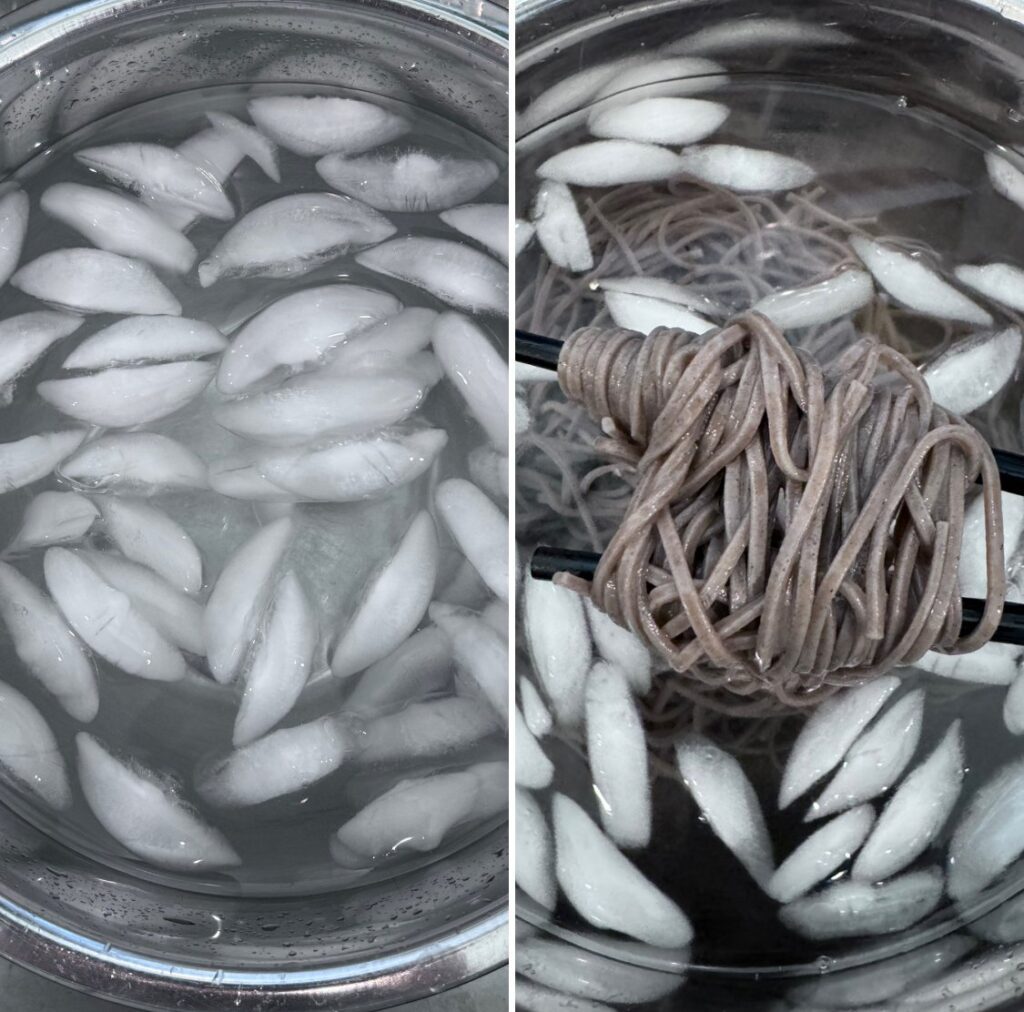There is absolutely nothing more refreshing than cold noodles in the Summer. When it’s scorching outside, the last thing I want to do is stand over a hot stove, so I love quick and easy meals that are light and refreshing. On those days when I don’t feel like cooking, this traditional Japanese noodle dish comes together in no time at all.
Cold Soba Noodles, or Zaru Soba, is a traditional Japanese cold noodle dish using buckwheat flour and served with a soy sauce-based dipping sauce called Tsuyu. Once cooked, the noodles are cooled and plunged into an ice bath to stop the cooking. The key here is to serve the noodles VERY cold. The noodles are served with condiments on the side, such as fresh scallions, wasabi paste, shredded nori leaves, and ginger. The noodles are dipped into the sauce very quickly, and slurping is highly encouraged!

SOBA NOODLES
Soba noodles are the most popular noodles in Japan. It is made of buckwheat, which is a type of seed (often mistaken for a grain) that has been grown since the Jomon era in the 4th century BC. The production of soba began in the 16th and 17th centuries during the Edo era. The noodles spread quickly throughout Japan, into the 19th century. In Japanese, the word soba means buckwheat.
When choosing a soba noodle, I like to choose one with more buckwheat flour as it is more flavorful. A pack of dried soba noodles usually comes in 2-4 bunches. Each bunch is for one serving and tied with a piece of paper or plastic tape. There are different varieties of soba noodles, but the main differences are texture and flavor, which comes down to the ratio of buckwheat four.
- Ju-wari Soba is made of 100% buckwheat flour. It has a dry and rough texture so the noodles will easily break. It may be hard to cook because of the dry and crumbly texture.
- Hachi-wari Soba is made of 80% buckwheat flour and 20% wheat flour. Hachi-wari means 80% in Japanese. The noodle is smoother and has an al dente texture. While it’s easier to chew, the buckwheat aroma is less pronounced than Ju-wari.
Cooking Soba Noodles
Nowadays, you can find quality dried soba noodles at most stores. They are usually cooked for 4-5 minutes in a large pot of boiling water. Traditionally, the water is not salted. After cooking, the noodles are plunged into the ice water to stop from cooking and ensure they remain al dente.
Zaru soba is eaten cold. This dish is served on a bamboo tray (zaru) and can be found in most Japanese stores. The word zaru means “a strainer” in Japanese. While soba noodles can be served as cold noodles like Zaru soba, they can also be served in hot soup with toppings. If you really want to enjoy the flavor of soba itself, I recommend that you eat it cold

Tips for Cooking Soba Noodles
- Before cooking, add water and plenty of ice to a large bowl to plunge noodles in after cooking
- Use plenty of water to cook the noodles in
- Separate the dried noodles when adding to the boiling water
- Using chopsticks, stir the noodles in the boiling water so they do not stick together
- After cooking, rinse the noodles under cold running water to remove excess starch
- Add the noodles to the ice bath to stop cooking. Remove and drain.
TSUYU (DIPPING SAUCE)
At the heart of Zaru Soba is the Tsuyu, or dipping sauce, a soy sauce and dashi-based dipping sauce. The dipping sauce can be made ahead of time and stored in the fridge. Making this sauce is a simple ration of dashi stock, soy sauce, and mirin—4:1:1 respectively. If you’ve ever had tempura, you will notice the sauces are very similar.
You can make your own dashi broth, but again, it’s hot and we don’t need to be spending all day over the stove. I use these dashi packets to make my broth. If you want to make your own dashi, this recipe is great from Just One Cookbook.

HOW TO EAT ZARU SOBA
Zaru soba is served with a small bowl of dipping sauce and condiments on the side. Some common condiments are finely chopped scallions, wasabi, grated ginger, grated daikon, pickled ginger, toasted sesame seeds, and shredded nori. Traditionally, each person chooses whichever condiment they would like to add to their dipping sauce.

Pick up some noodles with your chopsticks, dip only the bottom half of them in the sauce briefly, and slurp the noodles. The dipping sauce is salty, so you do not want to linger in it too long. By dipping only half the noodles in the sauce, you can taste the flavors of the noodles for a more authentic experience.

THE RECIPE
This Cold Soba Noodles (Zaru Soba) recipe is quick and easy and is the perfect midweek dinner. The noodles cook in just 5 minutes and the dipping sauce can be made in advance, although quick to make.

WHAT YOU WILL NEED:
- Wasabi (optional)
- Salt
- 1 cup dashi or chicken stock (if using dashi powder, use 1 tsp)
- 1/4 cup soy sauce
- 2 tablespoons mirin or 1 tablespoon honey mixed with 1 tablespoon water
- 8 ounces soba noodles
- Finely grated or minced ginger
- Minced scallions or toasted sesame seeds for garnish
- Shredded Nori Seaweed
Step 1: Bring a large pot of water to a boil. In a large bowl, add water and plenty of ice. Set aside. Cook noodles until tender for 4-5 minutes. Drain, and plunge the noodles into the ice water. Work by hand until the noodles are ice cold, then drain thoroughly.

Step 2: Combine dashi powder or stock (if using dashi powder, use 1 tsp), soy sauce and mirin. Taste, and add a little more soy if the flavor is not strong enough.

Step 3: Prepare your condiments by adding minced scallions, ginger, and wasabi, if using to a small plate. Place cold soba noodles on a plate and garnish with shredded seaweed nori. Pick up soba noodles, dip them in the dipping sauce briefly, and slurp the noodles.


✅ Quick Tips: Read the recipe in its entirety before you start cooking. This will help you understand the ingredients, steps, and timing involved, and allow you to prepare any necessary equipment or ingredients beforehand.

Cold Soba Noodles (Zaru Soba)
Ingredients
Nutritional Value
Nutritional Value
- Amount Per Serving
- Calories 295kcal
- % Daily Value *
- Total Fat 1g2%
- Sodium 2024mg85%
- Potassium 301mg9%
- Total Carbohydrate 62g21%
- Dietary Fiber 0.2g1%
- Sugars 3g
- Protein 15g30%
- Calcium 55 mg
- Iron 3 mg
* Percent Daily Values are based on a 2,000 calorie diet. Your daily value may be higher or lower depending on your calorie needs.










